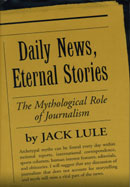
| Home News Releases | Calendar Contact |
Sources Bookshelf

Daily News, Eternal Stories
The Mythological Role of Journalism
Lule, Jack
Publisher: The Guilford Press, New York, USAYear Published: 2001
Pages: 245pp ISBN: 1-57230-608-4
Library of Congress Number: PN4759.L85 2001 Dewey: 070.4'3'01--dc21
Please see our media profile in Sources:
Sources Select Resources
There is a tendency to see the news strictly in terms of facts. The five Ws, argues Jack Lule, ought to make room for a sixth: What makes it a story?
In Daily News, Eternal Stories, Lule undertakes a series of case studies in order to explain how news is given relevance or, in some cases, unfairly shaped by myth, the "eternal stories" that predate the printed word.
He carries out eight compelling case studies of New York Times coverage, each case representing a mythic archetype which provides the "exemplary models" which inform journalistic storytelling through their values and assumptions: The Victim in the coverage of the killing of Leon Klinghoffer in the hijacking of the Achille Lauro in 1975; The Scapegoat in the coverage of the killing of former Black Panther Huey Newton in 1989; The Hero in coverage of baseball player Mark McGwire; The Trickster in the coverage of boxer Mike Tyson's 1992 conviction for rape; The Other World in the coverage of Haiti in the early 1990s; and of course, The Flood in the coverage of Hurricane Mitch and other disasters.
Sometimes, this is in the service of established social order, as some myths serve to deflect questions about the status quo. As Roland Bathes once pointed out, myths serve to make constructed values seem eternal and unchanging. In other cases, myth serves to render the senseless or incomprehensible meaningful to readers and reporters alike: "Myth is essential and always alive. The stories of myth are necessary to human lives and the societies they construct," and in some cases "They attempt to reconcile people to the vagaries of human existence -- to cruel fate, to bizarre happenstance, to death itself."
The ways in which he examines the coverage of Klinghoffer, the victim of a terrorist attack, and United States foreign policy vis-à-vis a Haiti are far more salient now than when he first wrote the book. These two chapters make for compelling reading.
Lule concludes with 12 propositions about the news, myth and society. He makes a point here that is worth noting in the context of media convergence and increasing concentration of ownership of media outlets. Some view the news, quite cynically and narrowly, as a means by which consumers may make informed decisions; others still see it as the means by which citizens may make informed decisions about public life. Instead, Lule argues, "Myth suggests that news is intimately entwined with all the wide-ranging issues and concerns of human existence, not just civic duties and purchasing problems....Myth means that the most complex phenomena of public life, from birth to death, will be captured in the dramatically compelling narratives of news." In this, he provides an antidote to the notion that people just want information served to them as fast as possible. What they really crave are stories, and stories told well.
If Lule is guilty of anything, it's that his style can sometimes be excessively earnest; he puts a great deal of time telling the reader what he is about to do in his analysis of these cases, and in the early going this can be a bit grating. That being said, the beauty of Lule's book is that he doesn't posit his analysis as a lens through which all news coverage should be viewed. A story about a fire, he says, is often just that. But he does do an excellent job of making the case that reporters and readers alike not only resort to myth as a way to explain things to themselves, but have an inherent need for these stories.
[Review by Andrew Vainio]
Table of Contents
Acknowledgements
INTRODUCTION Front-Page Myths: The News Story
I. THE STORY OF THE NEWS STORY
1 Seven Master Myths in the News: Eternal Stories
2 The Mythological Role of Journalism: Stories for Society
II. CASE STUDIES OF NEWS AS MYTH
3 The Victim: Leon Klinghoffer and News of Tragedy
4 The Scapegoat: The Killing of Huey Newton and Degrading Political Radicals
5 The Hero: Mark McGwire and "Godding up" U.S. Celebrities
6 The Good Mother: Mother Teresa and the Human Interest Story
7 The Trickster: Race, the News, and the Rape of Mike Tyson
8 The Other World: Haiti and International News Values
9 The Flood: Hurricane Mitch and News of Disasters
CONCLUSION News, Myth, and Society: Twelve Propositions
Notes
Index
About the Author
Subject Headings
© Sources 2023. The information provided is copyright and may not be reproduced in any form or by any means (whether electronic, mechanical or photographic), or stored in an electronic retrieval system, without written permission of the publisher.